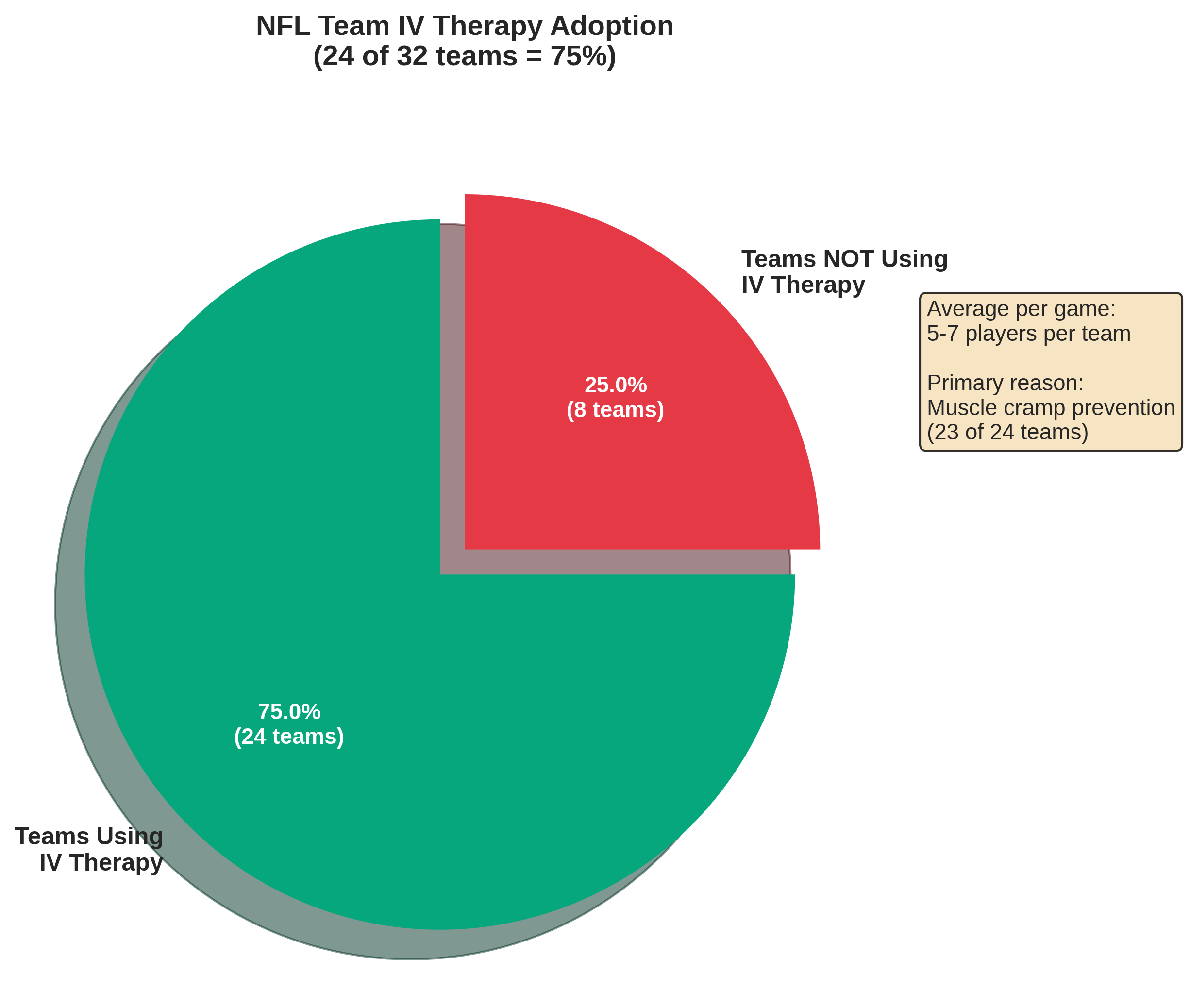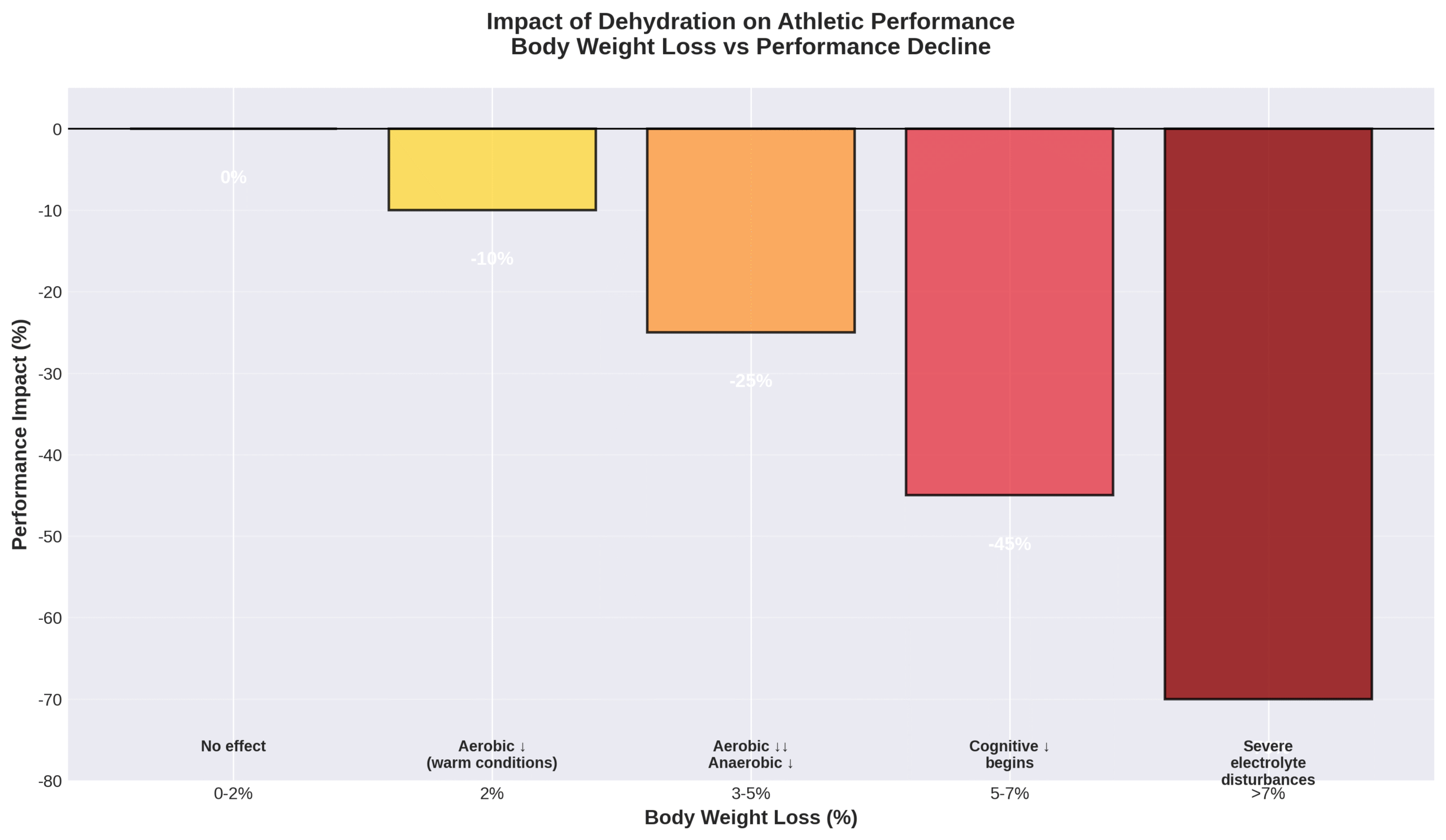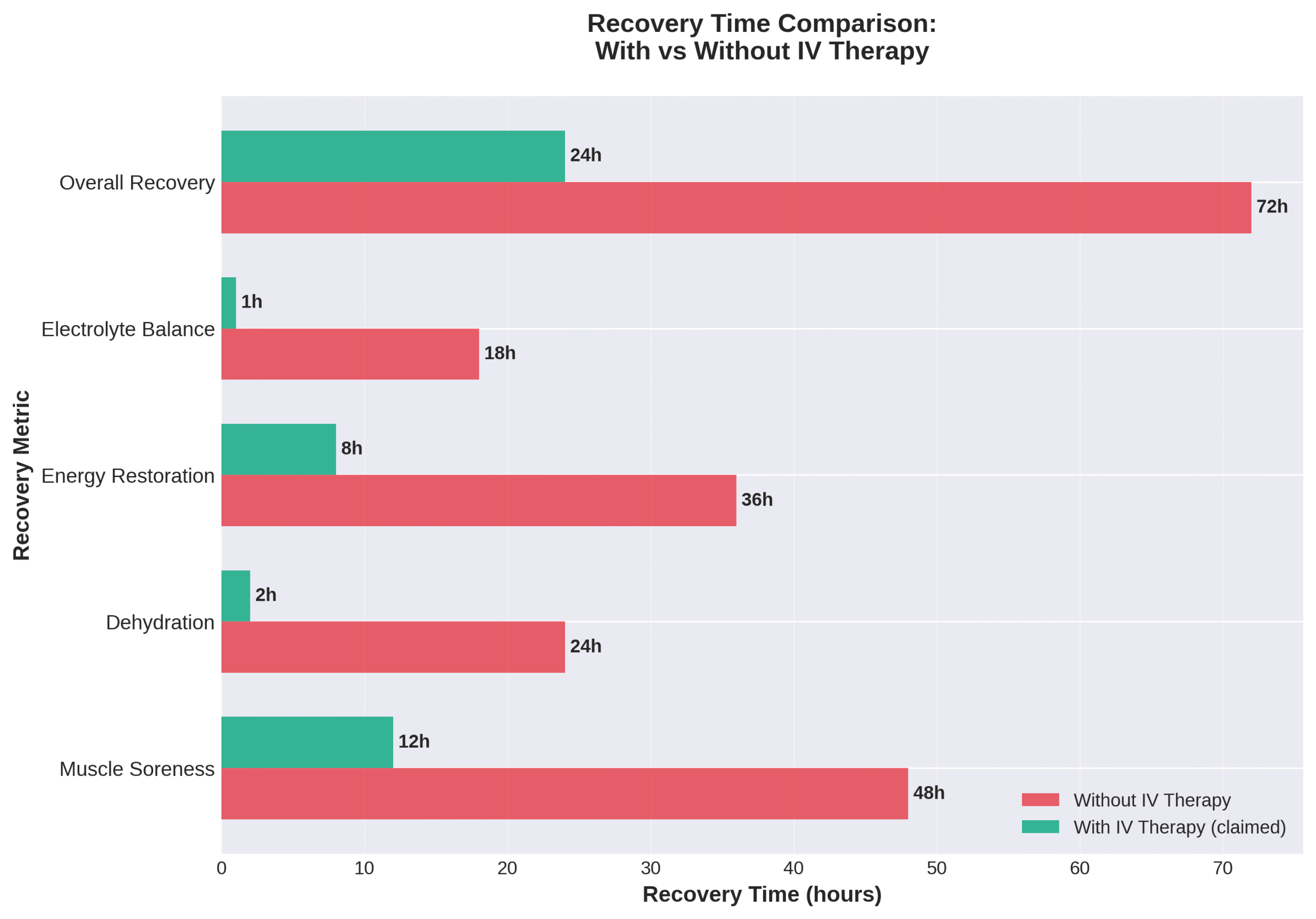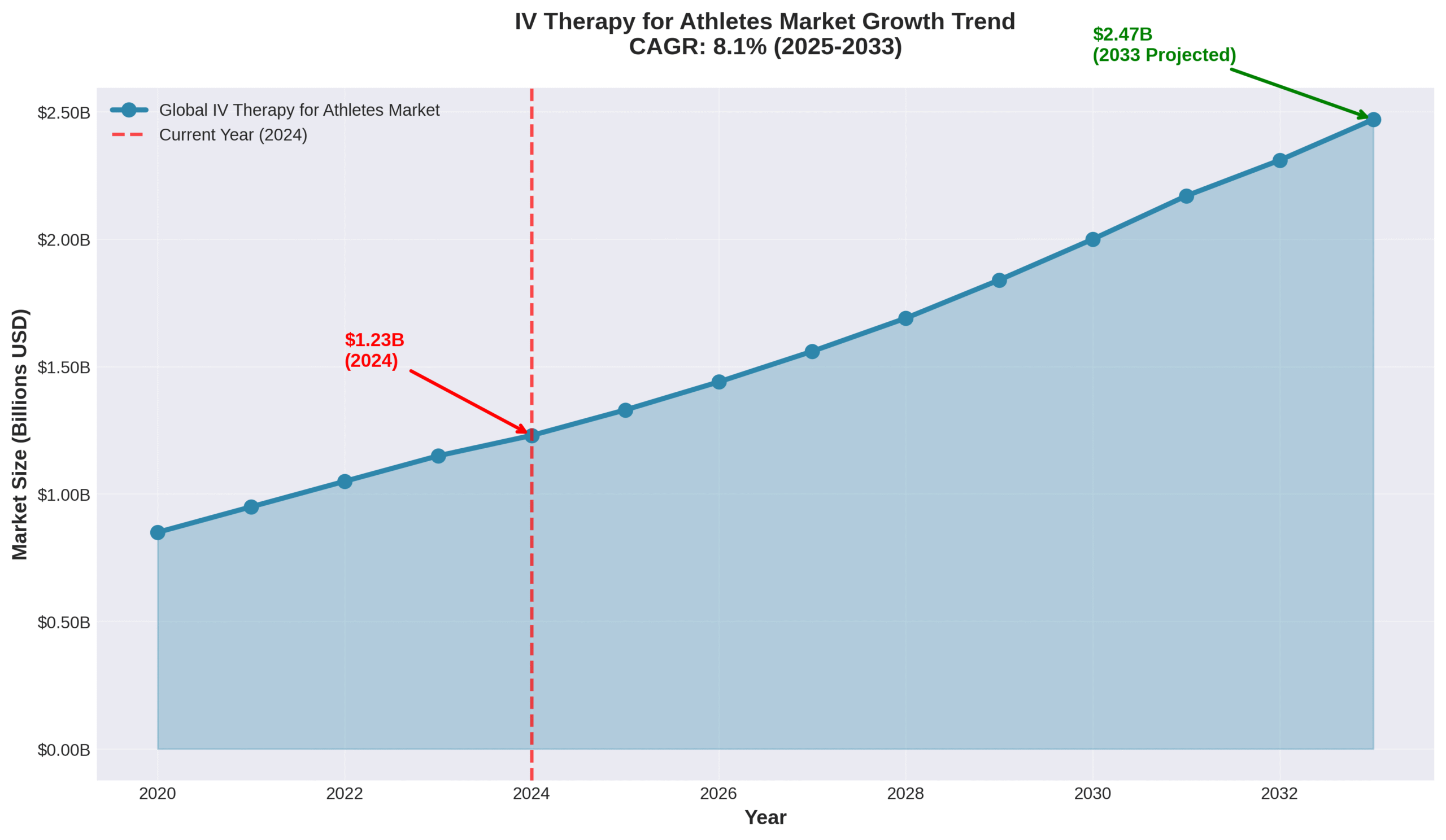If you’re searching for information about IV therapy for athletic performance, you’re likely an athlete or fitness enthusiast looking to optimize your recovery, enhance your performance, or address specific hydration and nutritional needs. Whether you’re dealing with intense training schedules, recovering from competitions, or seeking that competitive edge, we understand your desire to explore all available options for peak athletic performance. This comprehensive guide will help you understand the science, benefits, risks, and practical considerations of IV therapy in sports.
IV therapy for athletes is a medical treatment that delivers fluids, electrolytes, vitamins, and minerals directly into the bloodstream through an intravenous line, bypassing the digestive system entirely to achieve virtually 100% bioavailability. This therapeutic approach originated from military and emergency response team practices before expanding into elite sport settings, where it promises rapid rehydration, enhanced recovery, and optimized performance through immediate nutrient absorption.
According to a 2012 study published in Sports Health, 75% of NFL teams (24 of 32) use pregame IV fluid hyperhydration, with 5-7 players per team per game receiving treatment. The practice has gained significant traction despite limited scientific evidence. In 2009, a study at Mayo Clinic on fibromyalgia patients receiving Myers’ Cocktail showed that both the treatment and placebo groups reported similar improvements, highlighting the complex relationship between IV therapy and perceived benefits.

Key Findings and Evidence Summary
• Direct nutrient delivery – IV therapy achieves 100% bioavailability in 0-5 minutes compared to 20% for oral supplements taking 2+ hours
• NFL adoption patterns – 75% of teams use IV therapy primarily for muscle cramp prevention, despite lack of high-level evidence
• Performance impact thresholds – Dehydration of 2% body weight causes 10% aerobic capacity decline; 5-7% loss results in 45% performance decline
• WADA regulations – IV infusions greater than 100 mL per 12-hour period are prohibited in competition without therapeutic exemption
• Market growth trajectory – Global IV therapy market for athletes valued at $1.23 billion in 2024, projected to reach $2.47 billion by 2033
• Safety considerations – Risks include infection, thrombophlebitis, bleeding, and potential kidney damage from high vitamin doses
• Clinical legitimacy – Reserved for severe dehydration (>7% body weight loss), heat illness, or inability to tolerate oral fluids
The analysis reveals that IV therapy in athletics represents a rapidly growing market driven by wellness culture and athlete testimonials, yet scientific evidence remains limited. The practice delivers immediate hydration and nutrients with superior bioavailability compared to oral methods, making it attractive for athletes seeking quick recovery. However, professional organizations including the American College of Sports Medicine and USADA recommend a “food first” approach, reserving IV therapy for legitimate medical needs. The treatment’s popularity among professional athletes, particularly in the NFL and NBA, contrasts with regulatory restrictions from WADA and concerns about creating a “quick fix” mentality in younger athletes.
Practical Application for Athletes
For athletes considering IV therapy, we recommend starting with a medical evaluation to determine if you have conditions that genuinely impair nutrient absorption, such as GI disorders or post-bariatric surgery status. Focus on optimizing natural hydration through sports drinks, water, and nutrient-dense foods before exploring IV options. If pursuing IV therapy, ensure treatments occur at legitimate medical facilities following proper safety protocols, verify WADA compliance if you compete in governed sports, and schedule sessions 24-48 hours before competitions for optimal absorption while avoiding the 100 mL per 12-hour competition window restriction.
As we explore the mechanisms, benefits, risks, and practical applications of IV therapy for athletes, this guide will equip you with evidence-based information to make informed decisions about incorporating this treatment into your athletic performance strategy.
How Does IV Therapy Work for Athletic Performance and Recovery?
IV therapy for athletic performance and recovery is the direct delivery of fluids, electrolytes, vitamins, and minerals into the bloodstream through an intravenous line. This method bypasses the digestive system entirely, achieving 100% bioavailability compared to oral supplements’ average 20% absorption rate. The technique originated from military and emergency medicine before expanding to elite sports, with 75% of NFL teams now using pregame IV fluid protocols for 5-7 players per game.

The following subsections explore the specific nutrients used, hydration mechanisms, and comparative advantages of IV therapy versus oral supplementation for athletes.
What Nutrients Are Commonly Used in IV Therapy for Athletes?
The nutrients commonly used in IV therapy for athletes are primarily found in the Myers’ Cocktail formulation, containing Vitamin C (25%), B-Complex vitamins (20%), Vitamin B12 (15%), Magnesium (20%), Calcium (12%), and optional Glutathione (8%). Vitamin C serves as an antioxidant that reduces inflammation and promotes tissue repair. B-Complex vitamins convert food into energy while supporting brain function and metabolism. Magnesium relaxes muscles and supports cardiovascular function. Normal saline (0.9% NaCl) at 1.5L volume remains the standard IV fluid in NFL teams, administered 2.5 hours before competition.

How Does IV Therapy Support Hydration and Electrolyte Balance?
IV therapy supports hydration and electrolyte balance by achieving immediate restoration within 1 hour compared to 18 hours with oral hydration methods. Performance impacts from dehydration follow a predictable pattern:
| Body Weight Loss | Performance Decline | Additional Effects |
| 2% | 10% aerobic capacity decrease | Especially in warm conditions |
| 3-5% | 25% decline | Loss of anaerobic capacity |
| 5-7% | 45% decline | Cognitive deterioration begins |

Athletes lose fluids at 634 mL/hour through sweat, while oral absorption only replaces 550 mL/hour—creating an 86% replacement rate that IV therapy eliminates through direct bloodstream delivery.
What Is the Difference Between IV Therapy and Oral Supplements for Athletes?
The difference between IV therapy and oral supplements for athletes centers on bioavailability and absorption speed:
- IV Therapy: 100% bioavailability in 0-5 minutes
- Sports Drinks: 70% bioavailability in 15-20 minutes
- Water with Electrolytes: 60% bioavailability in 20-30 minutes
- Oral Supplements: 20% bioavailability in 2+ hours
Oral absorption faces limitations from conditions such as atrophic gastritis, IBD, celiac disease, and enzyme deficiencies. High-fiber diets bind minerals like zinc and magnesium, further reducing absorption. Despite these differences, the American College of Sports Medicine states “IV fluids do not provide an advantage over drinking oral fluids and electrolytes.”
Athletes must weigh IV therapy’s rapid delivery against its invasive nature and regulatory restrictions when choosing recovery methods.
Why Do Athletes Use IV Therapy for Recovery and Injury Prevention?
Athletes use IV therapy for recovery and injury prevention primarily to prevent muscle cramps and address dehydration-related injuries. According to NFL team reports, 23 of 24 teams using IV therapy cite muscle cramp prevention as their primary reason. Professional athletes like LeBron James have publicly discussed receiving IV fluids during NBA Finals for hydration and recovery. Marathon runners and triathletes particularly rely on hydration therapy to combat significant fluid loss. NFL quarterback Matt Hasselbeck won a Thursday night game after receiving IV hydration while sick, demonstrating rapid rehydration effects. Athletes report faster recovery from dehydration, jet lag, hangovers, and physical exhaustion after IV therapy.
The following subsections explore how IV therapy impacts muscle fatigue, recovery times, and injury prevention in athletic performance.
How Can IV Therapy Help Reduce Muscle Fatigue and Soreness?
IV therapy helps reduce muscle fatigue and soreness through direct delivery of recovery nutrients into the bloodstream. Athletes claim muscle soreness recovery time reduces from 48 hours to 12 hours with IV therapy based on anecdotal reports. B-complex vitamins in IV formulations support energy metabolism and muscle recovery at the cellular level. Magnesium delivered via IV helps relax muscles and ease stress on the cardiovascular and nervous systems.
Overall recovery time reportedly decreases from 72 hours to 24 hours with IV therapy according to user testimonials.

These rapid recovery claims lead many athletes to consider IV therapy for post-workout restoration.
Does IV Therapy Aid in Speeding Up Recovery Times After Intense Workouts?
IV therapy aids in speeding up recovery times after intense workouts by rapidly restoring fluid and nutrient levels. Dehydration recovery time reportedly reduces from 24 hours to 2 hours with IV therapy. Energy restoration claims improvement from 36 hours to 8 hours post-workout with IV treatment.
Endurance athletes particularly report benefits due to higher fluid loss during marathon running and triathlon events. Post-competition IV therapy administered immediately after intense physical activity claims to reduce recovery within hours versus days. Typical athlete frequency is once or twice per month during training, increasing to weekly during competitive seasons.
While recovery benefits appear promising, the role of IV therapy in actual injury prevention remains less clear.
Can IV Therapy Contribute to Injury Prevention in Sports?
IV therapy cannot definitively contribute to injury prevention in sports based on current scientific evidence. No published studies exist on IV fluid use during events, at intermission, or post-event as an ergogenic aid for injury prevention. No high-level studies confirm IV prehydration prevents dehydration or exercise-associated muscle cramps.
Growing incidence of dehydration-related injuries drives hydration therapy market segment growth. The IV therapy market for athletes valued at USD 1.23 billion in 2024, projected to reach USD 2.47 billion by 2033 at 8.1% CAGR. Expert consensus states “routine IV therapy cannot be recommended as best practice for the majority of athletes.”

Athletes considering IV therapy must weigh these limited prevention benefits against potential risks and regulatory considerations.
What Are the Potential Risks and Considerations of IV Therapy for Athletes?
The potential risks and considerations of IV therapy for athletes include regulatory violations, medical complications, and questionable safety standards at wellness facilities. WADA prohibits IV infusions greater than 100 mL per 12-hour period during competition. Medical risks encompass infection, thrombophlebitis, bleeding, hematoma, arterial puncture, and air embolism. High doses of certain vitamins and minerals via IV administration link to kidney damage, heart rhythm abnormalities, and blood pressure changes. Peripheral nerve damage and gastrointestinal symptoms occur from excessive vitamin and mineral doses through intravenous delivery. Oral hydration presents none of the invasive risks associated with IV administration.
Are There Any Side Effects or Risks Associated With Sports IV Therapy?
The side effects and risks associated with sports IV therapy include soft tissue infiltration, extravasation, and needle stick injuries. Improper IV placement causes soft tissue infiltration and extravasation. Healthcare providers face needle stick injury risks during IV therapy administration. IV bars and wellness centers use products of unknown composition, including observed “green solutions” of questionable content. Trauma, bleeding, and infection remain rare but possible complications of any IV placement. Treatment costs range from $100-$500 per session without insurance coverage for non-medical use.
Who Should Avoid IV Therapy or Take Extra Precautions?
Athletes who should avoid IV therapy or take extra precautions include those in WADA-governed competitions, NCAA wrestlers, and youth athletes. Athletes in WADA-governed competitions must avoid IV infusions over 100 mL per 12 hours without Therapeutic Use Exemption. NCAA wrestling specifically prohibits IV rehydration as violation of weight-management rules. Weight-class sport athletes in wrestling, MMA, and boxing face prohibition due to historical abuse for rapid rehydration after weight cutting. Athletes with clinically low iron levels may receive IV iron with proper TUE or volume limitations. Youth athletes should never receive IV infusions outside emergency medical care or diagnostic procedures per USA Swimming and USADA guidelines.
What Should Athletes Know About Regulation and Safety Standards for IV Therapy?
Athletes should know that regulation and safety standards for IV therapy include WADA compliance requirements, legitimate clinical uses, and variable quality control at wellness centers. Legitimate clinical uses encompass severe dehydration exceeding 7% body weight loss, exertional heat illness, and exercise-associated hyponatremia. Retroactive TUE application remains acceptable only in medical emergencies or under clinical time constraints. IV bars and wellness centers have no guarantee of following proper hygiene procedures or sterilization practices. FDA has not approved IV vitamin C therapy as treatment for cancer side effects despite some research. Australian Institute of Sport guidelines require balancing appropriate athlete care against WADA compliance requirements when considering IV therapy protocols.
Who Is a Good Candidate for Athletic IV Therapy?
Good candidates for athletic IV therapy are high-level athletes with documented medical needs requiring rapid nutrient delivery. Athletes experiencing severe dehydration exceeding 7% body weight loss need immediate IV intervention. Those unable to ingest oral fluids due to nausea, vomiting, or diarrhea represent legitimate candidates for IV therapy. Athletes with chronic malabsorption syndromes such as Crohn’s disease, celiac disease, or IBS may require IV nutrients when oral supplementation fails. Post-bariatric surgery athletes face impaired nutrient absorption that often necessitates IV supplementation for adequate nutrition.
What Types of Athletes Benefit Most From IV Therapy?
The types of athletes who benefit most from IV therapy are endurance athletes prone to significant fluid loss. Marathon runners and triathletes experience substantial dehydration during events, making them primary candidates for hydration therapy. Professional team sport athletes in the NFL, NBA, and soccer increasingly adopt IV therapy, with 75% of NFL teams using pregame IV fluid hyperhydration. Athletes recovering from surgery or experiencing acute illness may require rapid nutrient delivery through IV administration. The Asia Pacific market demonstrates this growing adoption, expanding at 9.3% CAGR and reaching USD 250 million in 2024, representing 20% of the global market. Athletes with documented vitamin or mineral deficiencies unresponsive to oral supplementation represent appropriate candidates for IV therapy.
Should Amateur or Youth Athletes Consider IV Therapy?
Amateur and youth athletes should not consider IV therapy outside emergency medical care. USA Swimming, TrueSport, and USADA explicitly state youth athletes should never receive IV infusions except for emergency treatment. No research demonstrates IV infusions for rehydration or vitamins are more effective than drinking fluids or eating vitamin-rich foods for young athletes. According to Dr. Laura Lewis from USADA, “Using IVs makes young athletes think there are shortcuts,” creating a slippery slope toward other performance-enhancing substances. Amateur athletes should follow a “food first” approach using water, sports drinks, and water-dense foods like watermelon for hydration. NSF Certified for Sport supplements offer safer alternatives to IV therapy based on doctor or dietitian guidance for amateur athletes.
How Does an Individualized IV Plan Get Created for an Athlete?
An individualized IV plan gets created for an athlete through comprehensive medical evaluation and assessment. Athletes with GI disorders, chronic illnesses, or conditions impairing nutrient absorption require medical evaluation before starting IV therapy. Tailored IV drip therapies include vitamin infusions, detox blends, and immune-boosting formulas based on individual nutritional deficiencies and performance goals.
Frequency adjusts from once or twice monthly during training periods to weekly or more frequent sessions during competitive seasons. Pre-competition protocols schedule IV sessions 24-48 hours before major competitions for optimal nutrient absorption and utilization. Doctors must understand WADA rules to adjust IV fluid amounts ensuring compliance for competitive athletes, limiting infusions to 100 mL per 12-hour period without a Therapeutic Use Exemption.
How Does IV Therapy Compare to Other Recovery Methods for Athletes?
IV therapy compares to other recovery methods for athletes by costing $100-$500 per session while massage, cryotherapy, and oral hydration cost significantly less. Normal rehydration is achieved in the vast majority of individuals by drinking sports drinks, water, and eating normal meals. Evidence-based alternatives include nutritious diet, physical activity, quality sleep, and mind-body therapies.
A 2009 fibromyalgia study showed the placebo group reported similar improvements to the Myers’ Cocktail group. Dr. Brent Bauer from Mayo Clinic states there is “limited evidence that IV vitamins provide benefit to people with normal nutritional intake.”
The following subsections examine specific advantages, disadvantages, and appropriate use cases for IV therapy versus traditional recovery approaches.
What Are the Advantages and Disadvantages Compared to Massage, Cryotherapy, or Oral Hydration?
The advantages and disadvantages compared to massage, cryotherapy, or oral hydration are distinct across delivery speed, safety, and cost factors. IV therapy delivers nutrients in 0-5 minutes versus 15-30 minutes for oral hydration methods. Massage and cryotherapy address muscle recovery without invasive procedures or infection risks.
| Type | Measurement | Value |
| IV therapy | Nutrient delivery time | 0-5 minutes |
| Oral hydration | Nutrient delivery time | 15-30 minutes |
| Sports drinks | Bioavailability | 70% |
| IV therapy | Cost per treatment | $250-$800 |
| IV therapy | Medical supervision | Required |
| Oral hydration | Needle complications | None |
IV therapy bypasses digestive system limitations but requires medical supervision and sterile technique. Cost-effectiveness favors traditional recovery methods over IV therapy’s premium pricing structure.
When Should Athletes Choose IV Therapy Over Other Recovery Strategies?
Athletes should choose IV therapy over other recovery strategies when severe dehydration exceeding 7% body weight loss warrants immediate IV intervention. There are specific medical conditions requiring IV therapy, such as exertional heat illness, hypernatremia when oral fluids cannot be tolerated, and exercise-associated hyponatremia requiring hypertonic IV infusion.
Hospital admissions, surgical procedures, or clinical diagnostic investigations justify IV use. Athletes experiencing nausea, vomiting, or diarrhea preventing oral intake may require IV fluids.
These clear medical indications represent situations where IV therapy provides essential treatment rather than optional performance enhancement.
What Should Athletes Expect During an IV Therapy Session?
IV therapy sessions for athletes cost $85-$180 for basic hydration with saline and electrolytes. Vitamin and nutrient therapy ranges $150-$300 per session including vitamins C, B-complex, and essential nutrients. Specialized treatments exceed $300 for advanced formulations and customized nutrient combinations.
The session involves IV placement in an arm vein with a fluid bag connected via tubing using gravity drip or pump delivery. Athletes must verify clinics follow proper health and safety protocols including needle sterilization and sterile technique. The following subsections detail preparation requirements, infusion duration, and safety considerations for athletic IV therapy.
How Can Athletes Prepare for Their First IV Therapy Appointment?
Athletes must disclose WADA compliance requirements if competing in governed sports. Medical history review includes current medications, allergies, and existing health conditions. Hydration status assessment may include vital signs and basic laboratory tests.
Athletes should eat a light meal 2-3 hours before appointment to prevent nausea. Loose clothing facilitates IV access and comfort during the 30-60 minute infusion period. Proper preparation ensures optimal treatment outcomes and minimizes potential complications.
How Long Does a Typical IV Infusion Take and How Soon Are Results Felt?
A typical IV infusion takes 30-60 minutes for standard 1.5 L normal saline delivery. Athletes report feeling effects within 0-5 minutes as fluids enter the bloodstream directly. Matt Hasselbeck used the bathroom “six or seven times” between 2 a.m. and 11 a.m. after IV treatment, demonstrating rapid fluid delivery.
Energy restoration effects occur within 8 hours compared to 36 hours with traditional recovery methods. Full nutrient absorption and utilization optimize when IV therapy is scheduled 24-48 hours before competition. These timeframes help athletes plan treatment sessions around training and competition schedules.
How Frequently Can Athletes Safely Receive IV Therapy?
The frequency for athletes during training is once or twice per month for general hydration and recovery. Competitive season frequency increases to weekly or more frequent based on schedule intensity. WADA regulations limit IV infusions to 100 mL per 12 hours during competition periods without a Therapeutic Use Exemption.
No long-term safety data exists for repeated IV vitamin therapy in healthy individuals. Medical supervision remains essential to monitor for cumulative effects of high-dose vitamins and minerals. Athletes should work with qualified healthcare providers to establish appropriate treatment frequency based on individual needs and regulatory compliance.
How Can You Optimize Your Athletic Recovery and Performance With The Drip IV Infusion?
The Drip IV Infusion optimizes athletic recovery through customized IV formulations tailored to individual performance goals and nutritional deficiencies. Mobile IV services deliver treatments directly to training facilities, homes, or competition venues, eliminating travel time for athletes. According to a 2024 market analysis, the North America IV hydration market reached USD 1.6 billion with an 8.7% compound annual growth rate projected through 2030. The US mobile IV hydration sector specifically shows remarkable growth from USD 568.25 million in 2024 to a projected USD 1,556.29 million by 2034.
Can The Drip IV Infusion Tailor IV Therapy Plans for Athletic Goals?
The Drip IV Infusion tailors IV therapy plans for athletic goals through performance enhancement protocols, recovery optimization strategies, and energy boost formulations. The vitamin therapy segment experiences rapid expansion driven by preventative health trends and personalized nutrition demands. Sports teams, fitness centers, and individual athletes increasingly adopt specialized wellness center services for competitive advantages.
A 2025 global market report projects the IV hydration therapy market will reach USD 4.60 billion by 2030 from USD 2.94 billion in 2025. Professional athletes endorse these services despite the absence of large-scale randomized controlled trials validating performance benefits.
What Are the Key Takeaways About IV Therapy for Athletes We Covered?
The key takeaways about IV therapy for athletes are its 100% bioavailability advantage, regulatory restrictions, market growth, expert recommendations, and legitimate medical applications. IV therapy achieves complete nutrient absorption compared to 20-70% bioavailability for oral supplements. WADA regulations prohibit IV infusions exceeding 100 mL per 12-hour period during competition to prevent masking and weight manipulation. The athletic IV therapy market grows at 8.1% CAGR, reaching USD 2.47 billion by 2033. The American College of Sports Medicine and USADA recommend a “food first” approach over routine IV therapy for healthy athletes. Medical necessity exists for severe dehydration, heat illness, and malabsorption conditions requiring physician oversight.
